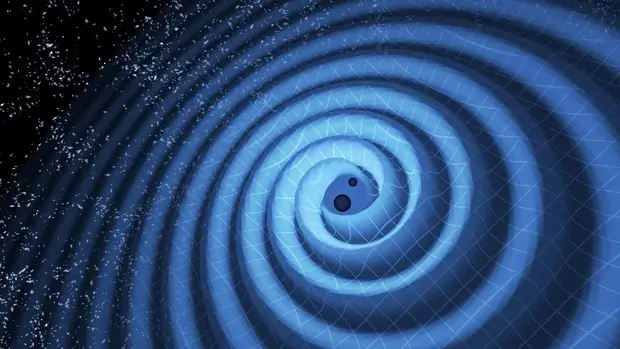
(Photo credit: CBC News)
This illustration shows the merger of two black holes and the gravitational waves that ripple outward as the black holes spiral toward each other. In reality, the area near the black holes would appear highly warped, and the gravitational waves would be difficult to see directly. (T. Pyle/LIGO)
The 2017 Nobel Prize in Physics has been awarded to three US scientists for their roles in detecting gravity waves, which was achieved for the first time in September 2015. Nanometrics’ Trillium 240 seismometers played a part in this important experiment, measuring ground motion in the massive LIGO detectors and feeding that back to actively cancel out vibrations in the detecting mirrors and lasers.
Just three men won this year’s Nobel Prize in Physics, but there were thousands of people involved in the gravitational wave discovery, including a Canadian team of astrophysicists.
“It took many, many, many people from many disciplines to build something extraordinary together,” says Aaron Zimmerman, a postdoctoral student at the Canadian Institute for Theoretical Astrophysics (CITA) at the University of Toronto.
“They acknowledged that it was LIGO as an experiment and as a collaboration that made this discovery, even if the prize went to some of the drivers at the heart of things,” Zimmerman said in an interview with CBC News.
Scientists detect gravitational waves for 1st time 0:51
Nanometrics Trillium 240 seismometer helps LIGO detect gravitational waves
Nanometrics’ Trillium seismometer technology was an important component in the Laser Interferometer Gravitational-wave Observatory (LIGO) installations that detected gravitational waves for the first time ever. Scientists announced this major scientific achievement yesterday, noting that the first gravitational waves seen at the twin LIGO installations, located in Livingston, Louisiana, and Hanford, Washington, were recorded September 14th, 2015, having been detected independently 7 milliseconds apart.
This story begins 1.3 billion years ago, in a galaxy far, far away…
Two black holes that had been spinning around each other in a gradually decaying orbit finally collided, converting enormous mass into energy radiated out as gravitational waves. The wave has been spreading out since then, finally reaching us last year. Nobody would have noticed it, except that back in 1992 the LIGO project was launched to set up observatories with 4 km long L-shaped laser interferometers operating in a near-perfect vacuum. These weren’t sensitive enough but “Advanced LIGO” was developed to upgrade the capabilities and it went online just six weeks before this first event was detected.
 LIGO researchers approached Nanometrics in March 2008, needing highly sensitive broadband seismometers that could measure the ever-present vibrations of the earth, so they could subtract the vibration effects out of the interferometer to help unmask fainter signals that would otherwise be drowned out. Nanometrics worked with LIGO to qualify and develop a custom version of the Trillium 240 broadband seismometer designed originally for measuring distant earthquakes. LIGO had a specialized list of requirements for this seismometer. It had to be suitable for deploying inside the huge vacuum chamber, and so needed to be as small as possible. It had to be extremely reliable and never need servicing, as a failure could mean months of downtime as the vacuum in the huge LIGO chamber was lost and then pumped back down again. LIGO also needed 50 seismometers delivered by early 2010. LIGO ultimately selected the Trillium 240 seismometer to instrument their vacuum chambers, not only because of the good performance shown in early tests at Stanford, but also for their proven history of reliability in the field.
LIGO researchers approached Nanometrics in March 2008, needing highly sensitive broadband seismometers that could measure the ever-present vibrations of the earth, so they could subtract the vibration effects out of the interferometer to help unmask fainter signals that would otherwise be drowned out. Nanometrics worked with LIGO to qualify and develop a custom version of the Trillium 240 broadband seismometer designed originally for measuring distant earthquakes. LIGO had a specialized list of requirements for this seismometer. It had to be suitable for deploying inside the huge vacuum chamber, and so needed to be as small as possible. It had to be extremely reliable and never need servicing, as a failure could mean months of downtime as the vacuum in the huge LIGO chamber was lost and then pumped back down again. LIGO also needed 50 seismometers delivered by early 2010. LIGO ultimately selected the Trillium 240 seismometer to instrument their vacuum chambers, not only because of the good performance shown in early tests at Stanford, but also for their proven history of reliability in the field.
“More specifically, the fifteen Trillium 240 seismometers in each observatory help keep the LIGO mirrors and lasers from being disturbed by vibrations. The seismometers measure the most minuscule ground motion, and other LIGO equipment feeds these signals back to help stabilize the detectors. It is a similar concept to noise-cancelling headphones that pick up room noise and create a reverse signal into your ear to make it quieter,” explains Bruce Townsend, VP of Products, Nanometrics, “This makes it possible for the scientists to measure the extremely tiny motions due to gravitational waves.”
When asked about the importance of the role the Trillium 240 seismometer played, Dr. Brian Lantz, Senior Research Scientist, Stanford University (LIGO) stated, “They are in vacuum in the instrument. They are a critical piece of the active seismic isolation we use. And they were (and still are) great!”
“We are thrilled that the Trillium 240 seismometer has played a role in enabling this significant scientific discovery,” said Neil Spriggs, CEO, Nanometrics, “and we are proud of the contribution Nanometrics made to help enable the LIGO success.”
For more information, go to: LIGO http://www.ligo.org/
See the Nobel prize CBC news article and Nanometrics’ February 2016 web news announcement for more information.
Nanometrics is dedicated to providing an open and honest scientific approach to Induced Seismicity Monitoring that has been honed by over 30 years of experience developing innovative seismic technology. Visit www.nanometrics.ca.

